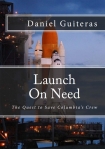Launch on Need, Daniel Guiteras [the giving tree read aloud TXT] 📗

- Author: Daniel Guiteras
Book online «Launch on Need, Daniel Guiteras [the giving tree read aloud TXT] 📗». Author Daniel Guiteras
The astronauts pulled the SCU (Servicing and Cooling Umbilical) cords from their suits. The umbilical cords connected their spacesuits directly to Columbia’s systems, like a battery connected to a charger, except that in addition to providing electrical power, Columbia’s systems also provided cooling, water and oxygen to their spacesuits. When the umbilicals were pulled, the EMUs (Extravehicular Mobility Unit—the specialized spacesuits used for spacewalks) switched automatically to their own power and resources. The astronauts were now self-contained in their suits; they had battery power for systems-monitoring and to run the suits, cooling systems, and oxygen tanks supplied that glorious life-sustaining hiss into their helmets.
All suit systems were go, and Earth waited.
“Houston, I’m heading out of the airlock now,” Jan said as she slowly pulled herself through the opening. Steve’s tether began unwinding, yielding to the progress Jan was making towards the slide wire. She was out of Steve’s sight now, but his tether continued to unwind, the steel cable spilling over the edge of the airlock in her direction. Steve remained still as she did this, safely secured by his grip on the airlock handholds.
Within several minutes she was at the port slide wire and had clipped in with her own tether, also a retractable, self-winding, 35-foot cable.
“Okay, Houston, I’m at the port slide wire, I’ve just clipped my tether to the slide wire and… Alright, Steve’s tether is now off my suit and on the slide wire as well.”
“Jan, we copy both tethers to the slide wire.”
Jan made her way aft along the slide wire, but was not able to see the leading edge of the wing in the region of RCC panels 6 through 9.
“Houston, I still have a negative visual of the leading edge of the wing as I travel aft on the slide wire. The payload bay doors are blocking my view.”
“We copy you, Jan. We expected a negative visual,” CapCom responded. “You’ll need to climb over the payload bay doors when you get to your mark.”
“Copy that.”
Steve stayed in the airlock waiting for his cue. Earlier, during his pre-breathe, he had convinced Houston to let him use a non-approved EVA camera to film any wing damage he might find. Since STS-107 was a mission that was designed to serve as a weightless laboratory, with no spacewalks necessary or planned, Columbia was not prepped with the special EVA helmet cameras that were capable of transmitting live video to Mission Control during spacewalks. Steve’s camera could capture video for Mission Control, but he would have to downlink it after the EVA was complete—there was no way to send a live video stream. Steve had proposed using the same camera he used to film the external tank separation from the flight deck during launch—a Sony PD-100. Houston’s issue was not whether or not the camera could record the damage; rather, they were worried the astronaut would not be able to safely attach the camera to his helmet. Carrying the camera by hand, all the way out to the wing, was not an acceptable risk. But Steve and the commander had found a way, using gray tape (what NASA calls duct tape), to affix the camera to his helmet with only minor loss of view out of the right side and top of the helmet. The two of them soon worried about a much bigger challenge—would Steve be able to start the recording once he was fully suited and his gloves were in place? The record button was small and tricky to push even for the ungloved hand; using the spacesuit’s oversized, tactile-starved gloves would make the task even more challenging.
They would get their answer soon enough.
More than 30 minutes had elapsed since Jan first left the airlock, and Steve was growing weary; he wanted to act. He hovered near the airlock directly over the payload bay, anxiously awaiting her report, all the while hoping she would not be able to quantify the wing damage alone—that she would need help, his help. Steve hated the thought that he may have gone through the whole process of pre-breathe and suiting-up for nothing more than hanging out in the open airlock.
“Houston, I’m at my mark, and I’m ready to climb out over the payload bay doors now,” Jan announced.
Up on the flight deck, the other four crew members watched Jan as she began her climb. Experiments on Columbia had been suspended—the access to the SpaceHab module was closed due to the use of the airlock for the EVA. They were still hopeful that the wing would be found intact so they could resume their work. But as the EVA wore on, and the ramifications of a damaged wing sank in, a quiet came over them; they began to worry as they watched their fellow crew member out in the payload bay.
Jan eased out over the payload bay door, her tether reel beginning to tug at her waist. She repositioned herself, checked her purchase. As her helmet reached the edge of the payload bay door, she looked up and there it was: Earth, staring back at her brighter and bigger than she remembered. She briefly became disoriented, a little dizzy, nauseous even, as Earth turned below her. She took two deep breaths, grasping the payload bay door, hoping the spinning would stop. Columbia, of course, was orbiting Earth at over 17,000 miles per hour, but there was no sense of this speed. It was not like the sense of speed you get while driving down a highway, whizzing past trees and buildings and other stationary objects. Astronauts performing spacewalks had none of those visual cues of speed.
To Jan, Columbia felt like it was a fixed point in space, not moving at all, and that Earth was spinning beneath her. She closed her eyes for a few seconds, hoping that shutting off the flow of visual information to her brain would help; but, instead, the feeling of nausea grew. Then she tried another approach; she opened her eyes and





Comments (0)